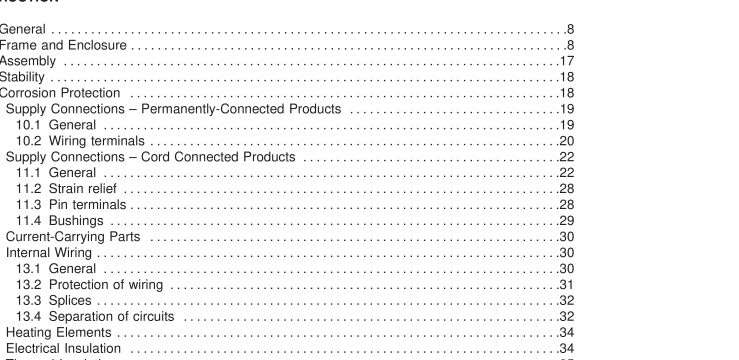UL 499-2008 pdf download.Electric Heating Appliances.
3 Units of Measurement 3.1 Values stated without parentheses are the requirement. Values in parentheses are explanatory or approximate information. 3.2 Unless indicated otherwise all voltage and current values mentioned in this Standard are root-mean-square (rms). 4 Undated References 4.1 Any undated reference to a code or standard appearing in the requirements of this standard shall be interpreted as referring to the latest edition of that code or standard. CONSTRUCTION 5 General 5.1 A heating appliance intended for use in a hazardous location is judged on the basis of its compliance with the requirements in this Standard, and further appropriate examination and tests to determine whether it is acceptable for the purpose. 5.2 Only materials that are acceptable for the particular use shall be used in a heating appliance. A heating appliance shall be made and finished with the degree of uniformity and grade of workmanship practicable in a well-equipped factory. 5.3 If the operation of a heating appliance involves the generation and confining under pressure of steam or other gas, consideration is to be given to the possibility of risk of explosion incident to such operation. This applies in the case of a product having immersed electrodes, where the electrolysis of water may result in the accumulation of oxygen and hydrogen. The product is not acceptable unless its strength has been investigated with respect to any risk of explosion that may be involved.
6 Frame and Enclosure 6.1 The frame and enclosure of a heating appliance shall be strong and rigid to resist the abuses to be encountered during intended use. The degree of resistance inherent in the product shall preclude total and partial collapse with the attendant reduction of spacings, loosening or displacement of parts, and other defects which alone or in combination constitute an increase in the risk of fire, electric shock, or injury to persons. 6.2 A vaporizer water reservoir of glass or similar material that might, upon breaking, cause skin lacerations shall be resistant to thermal-shock and impact. 6.3 A heating appliance shall be provided with an enclosure of material acceptable for the application, that shall house all electrical parts, except a supply cord and a recessed open-wire-element unit as mentioned in 1 4.3, that may result in risk of electric shock or injury to persons under any condition of use. If a heater is for permanent installation (intended for permanent connection to the power supply), the enclosure shall be provided with means for mounting in the intended manner and shall be furnished with any necessary fittings, such as brackets, hangers, or the like.
6.4 If openings for ventilation are provided in the enclosure of a heating appliance or in an externally mounted component intended for permanent connection to the power supply, they shall be so located that they will not vent into concealed spaces of a building structure, such as into false-ceiling space, into hollow spaces in the wall, and the like, when the product is installed. 6.5 Among the factors when an enclosure is being considered for acceptability, are its: a) Physical strength; b) Resistance to impact; c) Moisture-absorptive properties; d) Combustibility; e) Resistance to corrosion; and f) Resistance to distortion at temperatures to which the enclosure may be subjected under conditions of use. For a nonmetallic enclosure, all of these factors are to be considered with respect to thermal aging. 6.6 Cast- and sheet-metal portions of the enclosure shall be no thinner than indicated in Table 6.1 unless the enclosure complies with 6.5 and 6.7.
6.8 Electrical parts of a heating appliance, including open-wire elements, shall be so located or enclosed that protection against unintentional contact with uninsulated live parts will be provided (see also 24.6). Insulated motor brush caps do not require additional enclosure. 6.9 The enclosure shall be such that molten metal, burning insulation, flaming particles, or the like, is not likely to fall on combustible materials, including the surface upon which the enclosure is supported.UL 499-2008 pdf download.
UL 499-2008 pdf download
